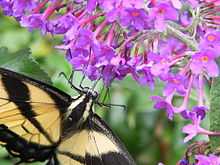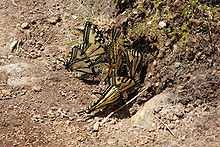Papilio canadensis
| Canadian Tiger Swallowtail | |
|---|---|
 | |
| In Ontario | |
| Scientific classification | |
| Kingdom: | Animalia |
| Phylum: | Arthropoda |
| Class: | Insecta |
| Order: | Lepidoptera |
| Family: | Papilionidae |
| Tribe: | Papilionini |
| Genus: | Papilio |
| Species: | P. canadensis |
| Binomial name | |
| Papilio canadensis (Rothschild & Jordan, 1906) | |
 | |
| Synonyms | |
|
Pterourus canadensis | |
The Canadian Tiger Swallowtail (Papilio canadensis) is a species of the Papilionidae family. It was once classified as a subspecies of Papilio glaucus.
Description


- Adult
The wingspan of this particular species is 67 to 80 mm. There are two adult morphs, yellow and black, although the black form is considered quite rare. This species is very similar to the Eastern Tiger Swallowtail, but has a noticeably smaller wingspan. Unlike the Eastern Tiger Swallowtail, the underside, yellow marginal band is continuous. The hindwing has many orange scales, on both morphs. This species has also been known to be hybridized with both the Eastern Tiger Swallowtail and Western Tiger Swallowtail even if this is extremely rare.
- Caterpillar
The caterpillar is large and green, with an enlarged head. It has 4 yellow dots and 2 false eyes with bluish centers. In profile, this caterpillar appears snake-like. The immature larvae are brown and white to mimic bird droppings, making them unappealing to predators.
Distribution
This butterfly is found in most provinces and territories in Canada, as its name implies. Its range extends north of the Arctic Circle in Yukon, and to Churchill in Manitoba, Little Shagamu River in Ontario, and to Schefferville in Quebec. It has not been reported from Labrador but has been seen in western Newfoundland. It is seen in the northern-third of the United States. Within this range it is a very common and well known butterfly, even more so around woodland edges. It is one of the most popular puddling species and often hundreds will gather at a single puddle.
Life cycle

Adults fly during spring and summer and there is 1 brood. Females lay eggs singly on the host plant. The caterpillar will fold the host plants leaves and tie them together with silk they will then eat from this structure. The pupae will over winter then emerge in May.
- Adult food
- Nectar
- Larval food
- Betula – birches
- Populus – poplars, aspens, and cottonwoods
- Malus – apple trees
- Prunus serotina - black cherry
References
- "Species Papilio canadensis - Canadian Tiger Swallowtail - BugGuide.Net". Retrieved 2009-01-26.
- "Butterflies and Skippers of North America - Papilio canadensis". Retrieved 2009-01-26.
- "Canadian Tiger Swallowtail". Butterflies and Moths of North America. Retrieved 2008-10-11.
- "Papilio canadensis". Retrieved 2009-01-26.
- Kaufman, Kenn; Brock, Jim P. (2003). "Swallowtails". Kaufman Field Guide to Butterflies of North America. Houghton Mifflin Books. pp. 20–21. ISBN 978-0-618-76826-4.
- Canadian Tiger Swallowtail, Butterflies of Canada
External links
| Wikimedia Commons has media related to Papilio canadensis. |
| Wikispecies has information related to: Papilio canadensis |
- Canadian Tiger Swallowtail, Butterflies of Canada